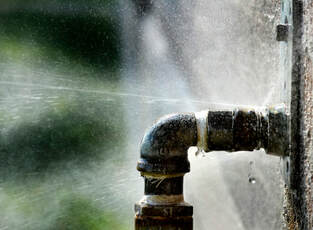We've noticed this post involving Leaking water lines below on the net and reckoned it made sense to write about it with you over here.

Early discovery of leaking water lines can reduce a possible disaster. Aside from conserving you cash, it will certainly decrease the aggravation and aggravation. The minute you discover a leak, calling your plumber for repair services is the most effective service. Nonetheless, some tiny water leakages might not show up. If you can not spot it with your nude eyes, below are some hacks that help.
1. Take A Look At the Water Meter
Every residence has a water meter. Checking it is a surefire way that helps you discover leaks. For starters, turn off all the water resources. Make certain no person will certainly purge, utilize the faucet, shower, run the washing machine or dishwasher. From there, go to the meter and also watch if it will certainly alter. Because nobody is utilizing it, there ought to be no motions. That shows a fast-moving leakage if it moves. Furthermore, if you detect no changes, wait a hr or 2 and also inspect back again. This means you may have a sluggish leakage that could even be below ground.
2. Check Water Usage
If you identify abrupt adjustments, regardless of your intake being the exact same, it indicates that you have leaks in your plumbing system. An abrupt spike in your expense shows a fast-moving leak.
Meanwhile, a constant boost every month, despite the same routines, reveals you have a slow leakage that's likewise gradually escalating. Call a plumber to completely inspect your residential property, especially if you feel a warm area on your flooring with piping below.
3. Do a Food Coloring Examination
When it comes to water intake, 30% comes from bathrooms. If the shade somehow infiltrates your dish during that time without flushing, there's a leakage between the container and dish.
4. Asses Exterior Lines
Do not neglect to inspect your outdoor water lines also. Ought to water seep out of the link, you have a loose rubber gasket. One little leak can throw away heaps of water and increase your water bill.
5. Assess the circumstance as well as check
Homeowners must make it a practice to check under the sink counters and also inside cupboards for any kind of bad odor or mold development. These 2 warnings suggest a leak so prompt interest is needed. Doing routine assessments, also bi-annually, can conserve you from a significant issue.
Check for stainings and compromising as most devices and also pipes have a life span. If you believe leaking water lines in your plumbing system, don't wait for it to intensify.
Early discovery of dripping water lines can reduce a prospective calamity. Some little water leaks may not be noticeable. Checking it is a guaranteed method that aids you discover leaks. One small leak can lose tons of water and also increase your water costs.
If you believe dripping water lines in your plumbing system, don't wait for it to rise.
WARNING SIGNS OF WATER LEAKAGE BEHIND THE WALL
PERSISTENT MUSTY ODORS
As water slowly drips from a leaky pipe inside the wall, flooring and sheetrock stay damp and develop an odor similar to wet cardboard. It generates a musty smell that can help you find hidden leaks.
MOLD IN UNUSUAL AREAS
Mold usually grows in wet areas like kitchens, baths and laundry rooms. If you spot the stuff on walls or baseboards in other rooms of the house, it’s a good indicator of undetected water leaks.
STAINS THAT GROW
When mold thrives around a leaky pipe, it sometimes takes hold on the inside surface of the affected wall. A growing stain on otherwise clean sheetrock is often your sign of a hidden plumbing problem.
PEELING OR BUBBLING WALLPAPER / PAINT
This clue is easy to miss in rooms that don’t get much use. When you see wallpaper separating along seams or paint bubbling or flaking off the wall, blame sheetrock that stays wet because of an undetected leak.
BUCKLED CEILINGS AND STAINED FLOORS
If ceilings or floors in bathrooms, kitchens or laundry areas develop structural problems, don’t rule out constant damp inside the walls. Wet sheetrock can affect adjacent framing, flooring and ceilings.
https://www.servicemasterbyzaba.com/blog/how-to-detect-water-leakage-in-walls/

Do you appreciate more info about Finding hidden leaks? Try to leave a remark further down. We will be pleased to hear your thoughts about this piece. We hope that you visit us again soon. You should take the opportunity to promote this write-up if you enjoyed reading it. Thanks for going through it.
Give Me A Quote!